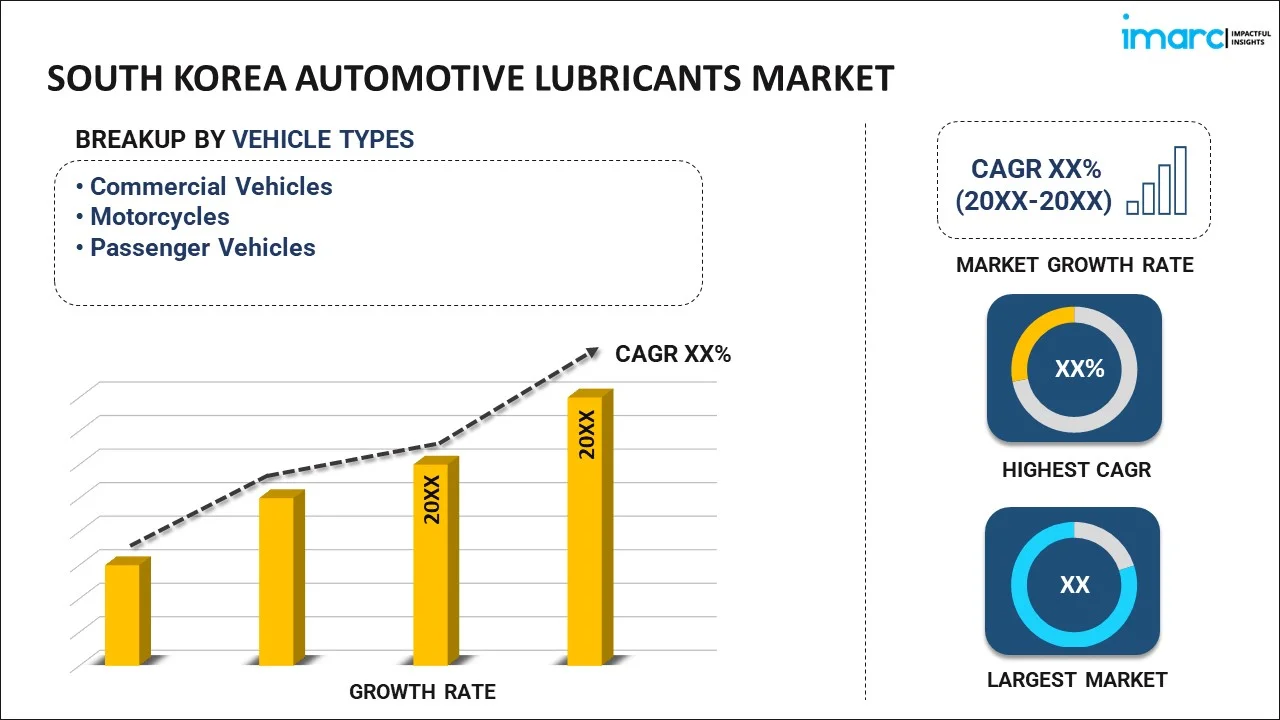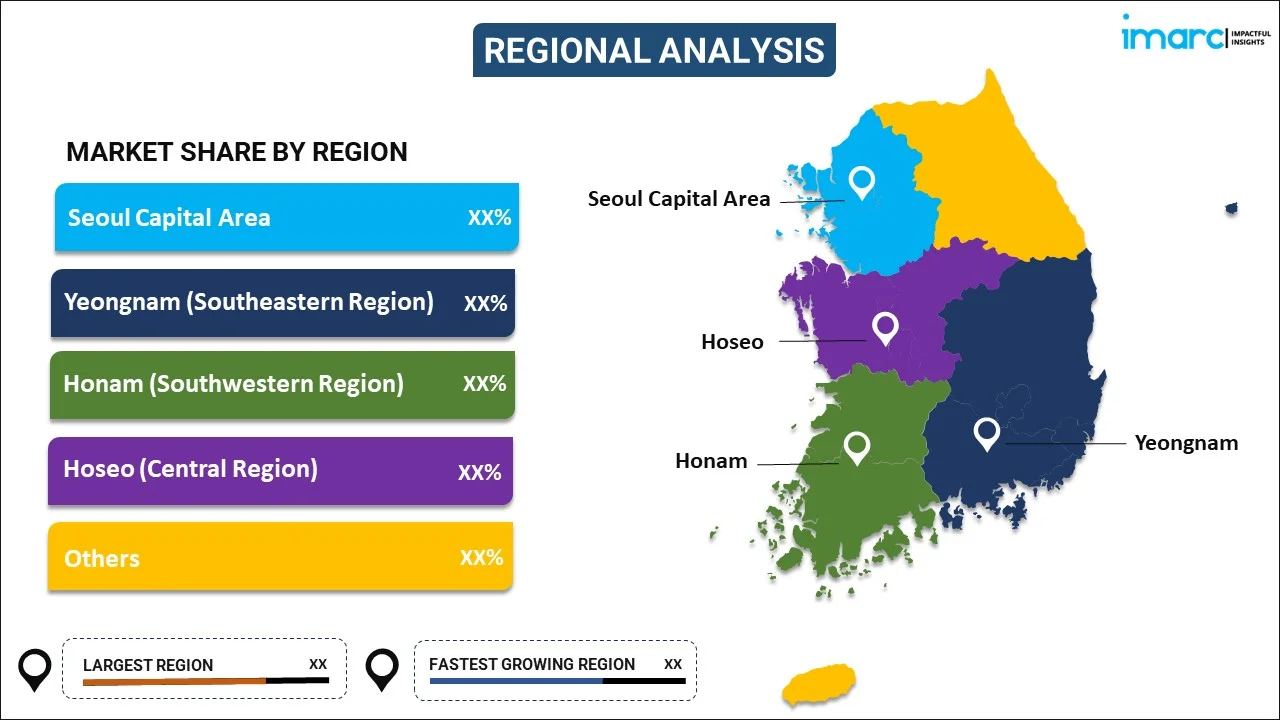
South Korea Automotive Lubricants Market Report by Vehicle Type (Commercial Vehicles, Motorcycles, Passenger Vehicles), Product Type (Engine Oils, Greases, Hydraulic Fluids, Transmission and Gear Oils), and Region 2025-2033
Market Overview:
The South Korea automotive lubricants market size is projected to exhibit a growth rate (CAGR) of 2.6% during 2025-2033. The growing number of vehicles on roads, the emerging development of advanced formulations that provide better protection and fuel efficiency, and the implementation of several government initiatives to reduce pollution and improve air quality represent some of the key factors driving the market.
|
Report Attribute
|
Key Statistics
|
|---|---|
|
Base Year
|
2024 |
|
Forecast Years
|
2025-2033 |
|
Historical Years
|
2019-2024
|
| Market Growth Rate (2025-2033) | 2.6% |
Automotive lubricants are essential fluids developed to reduce friction and heat within the various components of vehicles, primarily engines. These specialized fluids ensure the smooth operation and longevity of automotive machinery. It serves as a protective barrier between moving parts, preventing direct metal-to-metal contact that can lead to wear and tear. It minimizes friction and heat generation by forming a thin, lubricating film between mechanical components, such as pistons, bearings, and camshafts. It also reduces wear and enhances fuel efficiency and engine performance. Moreover, lubricants aid in dissipating heat generated during combustion, preventing overheating and potential engine damage. It is available in various forms, including engine oils, transmission fluids, and gear oils, each developed for specific applications within a vehicle. For instance, engine oils are formulated to maintain engine cleanliness, reduce deposits, and provide anti-corrosion properties. Also, transmission fluids ensure smooth gear shifts and protect against excessive wear, while gear oils are tailored to the requirements of differentials and gearboxes.
South Korea Automotive Lubricants Market Trends:
The South Korea automotive lubricants market is primarily driven by the rising number of vehicles on roads over the past decade. In addition, more vehicles mean more demand for lubricants to keep engines running smoothly, which is influencing the market growth. Moreover, lubricant manufacturers are developing advanced formulations that provide better protection and fuel efficiency, which is encouraging vehicle owners to opt for higher-quality lubricants, representing another major growth-inducing factor. Besides this, the implementation of several government initiatives to reduce pollution, improve air quality, and promote the use of eco-friendly vehicles resulting in the adoption of high-quality lubricants to meet emission targets, which is accelerating the demand for better lubricants. Also, electric and hybrid vehicles require specialized lubricants, creating an additional market for lubricant manufacturers, which is augmenting the market growth. Along with this, the growing industrial activity in South Korea, including the manufacturing sector that includes automobile production, is escalating the demand for commercial vehicles and heavy machinery, propelling the market growth. Apart from this, the growing awareness among vehicle owners about the importance of regular maintenance includes using the right lubricants to extend the lifespan of their vehicles, reducing repair costs in the long run, and contributing to market growth. Furthermore, manufacturers are expanding their distribution networks, making their products more accessible to consumers, which is facilitating market growth by reaching a wider audience.
South Korea Automotive Lubricants Market Segmentation:
IMARC Group provides an analysis of the key trends in each segment of the market, along with forecasts at the country level for 2025-2033. Our report has categorized the market based on vehicle type and product type.
Vehicle Type Insights:

- Commercial Vehicles
- Motorcycles
- Passenger Vehicles
The report has provided a detailed breakup and analysis of the market based on the vehicle type. This includes commercial vehicles, motorcycles, and passenger vehicles.
Product Type Insights:
- Engine Oils
- Greases
- Hydraulic Fluids
- Transmission and Gear Oils
A detailed breakup and analysis of the market based on the product type have also been provided in the report. This includes engine oils, greases, hydraulic fluids, and transmission and gear oils.
Regional Insights:

- Seoul Capital Area
- Yeongnam (Southeastern Region)
- Honam (Southwestern Region)
- Hoseo (Central Region)
- Others
The report has also provided a comprehensive analysis of all the major regional markets, which include Seoul Capital Area, Yeongnam (Southeastern Region), Honam (Southwestern Region), Hoseo (Central Region), and others.
Competitive Landscape:
The market research report has also provided a comprehensive analysis of the competitive landscape in the market. Competitive analysis such as market structure, key player positioning, top winning strategies, competitive dashboard, and company evaluation quadrant has been covered in the report. Also, detailed profiles of all major companies have been provided.
South Korea Automotive Lubricants Market Report Coverage:
| Report Features | Details |
|---|---|
| Base Year of the Analysis | 2024 |
| Historical Period | 2019-2024 |
| Forecast Period | 2025-2033 |
| Units | Million Litres |
| Scope of the Report | Exploration of Historical Trends and Market Outlook, Industry Catalysts and Challenges, Segment-Wise Historical and Future Market Assessment:
|
| Vehicle Types Covered | Commercial Vehicles, Motorcycles, Passenger Vehicles |
| Product Types Covered | Engine Oils, Greases, Hydraulic Fluids, Transmission and Gear Oils |
| Regions Covered | Seoul Capital Area, Yeongnam (Southeastern Region), Honam (Southwestern Region), Hoseo (Central Region), Others |
| Customization Scope | 10% Free Customization |
| Post-Sale Analyst Support | 10-12 Weeks |
| Delivery Format | PDF and Excel through Email (We can also provide the editable version of the report in PPT/Word format on special request) |
Key Questions Answered in This Report:
- How has the South Korea automotive lubricants market performed so far and how will it perform in the coming years?
- What has been the impact of COVID-19 on the South Korea automotive lubricants market?
- What is the breakup of the South Korea automotive lubricants market on the basis of vehicle type?
- What is the breakup of the South Korea automotive lubricants market on the basis of product type?
- What are the various stages in the value chain of the South Korea automotive lubricants market?
- What are the key driving factors and challenges in the South Korea automotive lubricants?
- What is the structure of the South Korea automotive lubricants market and who are the key players?
- What is the degree of competition in the South Korea automotive lubricants market?
Key Benefits for Stakeholders:
- IMARC’s industry report offers a comprehensive quantitative analysis of various market segments, historical and current market trends, market forecasts, and dynamics of the South Korea automotive lubricants market from 2019-2033.
- The research report provides the latest information on the market drivers, challenges, and opportunities in the South Korea automotive lubricants market.
- Porter's five forces analysis assist stakeholders in assessing the impact of new entrants, competitive rivalry, supplier power, buyer power, and the threat of substitution. It helps stakeholders to analyze the level of competition within the South Korea automotive lubricants industry and its attractiveness.
- Competitive landscape allows stakeholders to understand their competitive environment and provides an insight into the current positions of key players in the market.
Need more help?
- Speak to our experienced analysts for insights on the current market scenarios.
- Include additional segments and countries to customize the report as per your requirement.
- Gain an unparalleled competitive advantage in your domain by understanding how to utilize the report and positively impacting your operations and revenue.
- For further assistance, please connect with our analysts.
 Inquire Before Buying
Inquire Before Buying
 Speak to an Analyst
Speak to an Analyst
 Request Brochure
Request Brochure
 Request Customization
Request Customization




.webp)




.webp)












